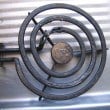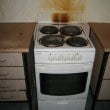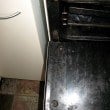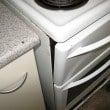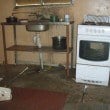B4.4 Cooking
Cooking preferences and needs vary between households. Some families will use a basic stove to cook, while others may use a range of cooking appliances, including microwave oven, rice cooker, deep fryer, electric frying pan, toaster and electric kettle. Some families might want to cook on a fire or barbeque area outside, while others will use a full outdoor kitchen with sink, bench and cooking facilities.
Whatever appliance is used, the ability to cook food is essential and will require functioning health hardware inside and / or outside the house.
In Australia, survey data from over 6,000 houses show that 3% of surveyed houses had no cooktop installed, and 69% of houses had a fully functional cooktop and 73% of the houses had a working oven.
It is important to select stoves that are designed to cater for regular use, are easy to clean and maintain, and can easily be removed for repairs or replacement. ‘Off-the-shelf’ upright stoves with a combined cooktop and oven are very common, but the cheaper models are often not designed to cater for the demands of a large family or harsh environmental conditions. Upright stoves provide nesting places for rodents and cockroaches in the many holes available in exposed areas at the back and on the bottom of these appliances.
Cooking can be very expensive for the household. An electric hotplate can cost over $3 a day to run. Based on the use of elements rated in total at 6kw being used for a total of 2 hours a day at 25c/kWh =12kw x 25c/kWh= $3 per day or $90 a month. And an electric oven if warmed and then run for 60 minutes will consume 3.5kW a day costing $1 a day or $30 a month. The combined cost of oven and cooktop cooking maybe as high as $120 a month. (All costs are in Australian dollars based on known energy costs 2013 and the usage quoted come from data logging information from many stoves used in a range of houses with varying populations, seasons and environmental conditions.)
Detailed data logging of several different households, where crowding is common, show that these cooking times and costs are not unrealistic.
Gas can be cheaper where it is available, but in rural and remote locations the cost of gas cooking can be as high as the cost of using electricity. It can be difficult to supply and change gas bottles where reticulated gas is not available. Residents may also worry about the safety of gas, which means it may not be the preferred cooking option. Survey data indicates that gas cooking appliances are less common (16%) than electric appliances (82%).
Other ways to cook in the kitchen can be essential if the house is crowded or the main cooking appliance is not functioning. Data showed 73% of houses had access to one or more of appliances like frying pans, microwave ovens, rice cookers or vertical grillers. This represented a significant rise of 8% since 2013 that may reflect that alternate ways of cooking are essential given the generally poor performance of the main cooking appliance in houses.
It is also important to consider using outdoor cooking areas, that do not rely on the inside house kitchen, such as barbeques or fire pits for cooking food. These cooking places will need fuel, wind protection and safe siting if near the house. Survey data show 48% of houses had access to an outside cooking area, a rise of 2% since 2013.
When specifying the stove, discuss with the residents and housing managers:
- the type of stoves that have been previously used and the successes or failures experienced
- the benefits of standardising stoves across the locality or region to increase purchasing power and to rationalise spare parts and maintenance
- the benefits of electric versus gas cooking in terms of running costs, ability to refill gas bottles, availability of electricians or gas fitters for maintenance, and preferences for cooking with gas or with electricity
- the benefits of upright stoves versus cooktops and wall ovens, and the merits of using a separate cooktop and oven that can be fully sealed into a bench top versus the difficulty and expense of repairing and replacing these units
- the need to provide separate cooktops and wall ovens that can be accessed by people with disabilities.
Design and Specification
Ensure
- B4.4 .1.
stoves and outdoor cooking facilities are specified and detailed in the building contract
- B4.4 .2.
the cooktop has elements or burners suited to big pots, with a minimum number of removable parts
- B4.4 .3.
there is capacity on, and around, the stove top for large pots to overhang the hotplates on both sides
- B4.4 .4.
behind the stove, there is an easy to clean, heat resistant splash back at least 600mm high
- B4.4 .5.
there is space around the stove for cleaning, and there are no small gaps between the stove and bench or cupboards that cannot be cleaned
- B4.4 .6.
the specification of any upright stoves, separate ovens and cooktops includes the sealing of any holes or exposed areas to eliminate nesting places for rodents and cockroaches
- B4.4 .7.
no cupboards, shelves or low windows are located above the stove
- B4.4 .8.
for electric stoves - ensure that an isolation switch is fitted within easy reach on the wall near the stove, accessible for someone using a wheelchair, and that the stove is connected to a separate electrical circuit
- B4.4 .9.
the stove is secured to prevent children climbing on it and tipping it over, using an anti-tilt bracket, but can be removed for cleaning and maintenance
- B4.4 .10.
there are power points for a variety of cooking appliances located away from the stove and sink
- B4.4 .11.
the kitchen has natural ventilation for the removal of cooking fumes and odours.
Consider
- providing an exhaust fan or other types of mechanical ventilation to remove cooking fumes and odours
- making provision for a microwave oven on a shelf or deeper bench area with a power point)
- specifying stove models that have cooktop and oven knobs that are robust, difficult to remove, and out of reach of children
- installing ovens between 400mm and 1000mm above the floor, with side-opening doors and a bench immediately next to the oven to allow access for elderly people and people with disabilities
- vermin-proofing the rear and bottom of stoves with mesh or a reliable and safe vermin kit and confirm that this does not make the stove unsafe or void the stove warranty.
- for people who use wheelchairs consider a model that has controls at the front or side of the oven and cooktop. For people with poor hand control raised crossbars for safe grip
- providing a clear circulation space of 1500mm x 820mm to allow a forward approach to the cooktop by people with disabilities, no more than 500mm of this clear floor space should extend under the cooktop
- providing an outdoor cooking area on the verandah or in the yard in addition to an indoor kitchen
- when selecting and locating outdoor cooking equipment, identifying the local area fire restrictions and risks as well as what food is likely to be cooked
- specifying a different type of fuel for the outdoor cooking area, to allow the outdoor kitchen to be used when gas or electricity is not available for the indoor kitchen
- for people with vision impairment installing an oven and cooktop with manual rather than digital controls
- for electric stoves specify - solid hotplates, which are stronger than coil elements, but can corrode when used in tropical and coastal areas
- for electric stoves - installing a stove timer switch to cut off power after a time specified by residents, to prevent the stove operating for long periods resulting in wasted electricity and expense to the household
- for electric stoves - use a plug, cable and power point to connect the stove to electricity, rather than a fixed connection, to allow the stove to be removed for cleaning, maintenance and replacement
- for gas stoves - using bayonet type gas connections for gas cooking appliances
- for gas stoves - specify a gas fuse to all burners and the oven to cut off gas supply when there is no flame
- for gas stoves - making provision for a portable gas cooker connected to a small gas bottle as a cooking option
For maintenance consider:
- organising annual maintenance and cleaning of all stoves to extend the life of the stoves.
When upgrading houses, consider:
- installing a timing switch on electric stoves to cut off electricity after a time specified by residents, for example, two hours
- replacing electric stoves with other cooking options that will be cheaper to use and discuss the advantages and disadvantages with residents and housing manager
- installing a stove with side or front controls with raised crossbars, which are easier for people with disabilities to grip.
Real world examples of Solutions
-
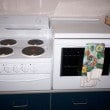 Elevated stove and oven unit
Elevated stove and oven unit -
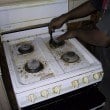 Cleaning gas burners
Cleaning gas burners -
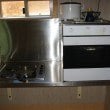 Elevated stove and oven unit
Elevated stove and oven unit -
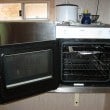 Oven swinging door
Oven swinging door -
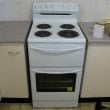 Controls on stove unit at back away from children
Controls on stove unit at back away from children -
 Note the 2 outside cooking places here - the drum oven and the recently used fire area in the foreground
Note the 2 outside cooking places here - the drum oven and the recently used fire area in the foreground -
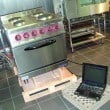 Stoves are one of the worst performing appliances in the house, New design being tested.
Stoves are one of the worst performing appliances in the house, New design being tested.
- B4.4 .1.
Quality control
- kitchen cooking equipment and kitchen components are installed as detailed and specified in the contract

- COMPLETED DESIGN & SPECIFICATION
DURING CONSTRUCTION
AT HANDOVER
FINAL COMPLETION
TRADE TEST
- COMPLETED DESIGN & SPECIFICATION
- all stove control knobs are fitted

- AT HANDOVER
FINAL COMPLETION
TRADE TEST
- AT HANDOVER
- all stove burners, elements, oven and grill are working

- AT HANDOVER
FINAL COMPLETION
- AT HANDOVER
- the oven door opens and fully seals when the door is shut

- AT HANDOVER
FINAL COMPLETION
TRADE TEST
- AT HANDOVER
- the stove has been secured with an anti-tilt device

- COMPLETED DESIGN & SPECIFICATION
DURING CONSTRUCTION
AT HANDOVER
FINAL COMPLETION
TRADE TEST
- COMPLETED DESIGN & SPECIFICATION
- stove vermin-proofing has been installed, if specified

- COMPLETED DESIGN & SPECIFICATION
DURING CONSTRUCTION
AT HANDOVER
FINAL COMPLETION
- COMPLETED DESIGN & SPECIFICATION
- kitcehn shelves or cupboards have not been fitted over the stove

- COMPLETED DESIGN & SPECIFICATION
DURING CONSTRUCTION
- COMPLETED DESIGN & SPECIFICATION
- there is a heat resistant, easy to clean splashback as required by the stove type

- COMPLETED DESIGN & SPECIFICATION
DURING CONSTRUCTION
AT HANDOVER
- COMPLETED DESIGN & SPECIFICATION
- the outdoor kitchen or alternate cooking area has been constructed as designed.

- COMPLETED DESIGN & SPECIFICATION
DURING CONSTRUCTION
AT HANDOVER
FINAL COMPLETION
- COMPLETED DESIGN & SPECIFICATION
- for an electrical stove, trade test the timer switch for the oven and stove

- TRADE TEST
- for an electrical stove, trade test the isolation switch and check it has been installed in a location that can be reached by people with disabilities

- TRADE TEST
- for an electrical stove, trade test the installation of a separate oven and stove circuit.

- TRADE TEST
- for a gas stove, trade test the installation is fully operational and issue a certificate of compliance.

- TRADE TEST
- kitchen cooking equipment and kitchen components are installed as detailed and specified in the contract
Maintenance
As part of cyclical maintenance, check that:
- all stove burners or elements are working

- Electrician, Local Maintenance Team, Stove Specialist, Gas Plumber
- 6 Months
- the oven is working

- Electrician, Local Maintenance Team, Stove Specialist, Gas Plumber
- 6 Months
- all stove control knobs are fitted and working

- Electrician, Local Maintenance Team, Stove Specialist, Gas Plumber
- 6 Months
- the oven door opens properly and fully seals when closed, and that the oven door glass is not cracked

- Stove Specialist
- 6 Months
- on electric stoves, the timer, isolation and safety switches are working.

- Electrician
- 12 Months
- all stove burners or elements are working
Standard And References
AS 1428.1:2021 Design for access and mobility - General requirements for access - New building work
AS 4299–1995, Adaptable housing.
Livable Housing Design Guidelines, 2017, Livable Housing Australia
Your Home - Indoor air quality (2021) - https://www.yourhome.gov.au/live-adapt/indoor-air-quality
Peter, S. and Tietz, C. 1997 in B Lloyd (ed.), Indoor stoves for remote communities. NTRC report, 97/8, Centre for Appropriate Technology Inc., Alice Springs.
Teitz, C 2000, Kitchen Design, Installation and Maintenance in G Harris (ed.), Environmental Health Handbook: A Practical Guide for Remote Communities, Menzies School of Health Research, Casuarina, pp. 15572.

